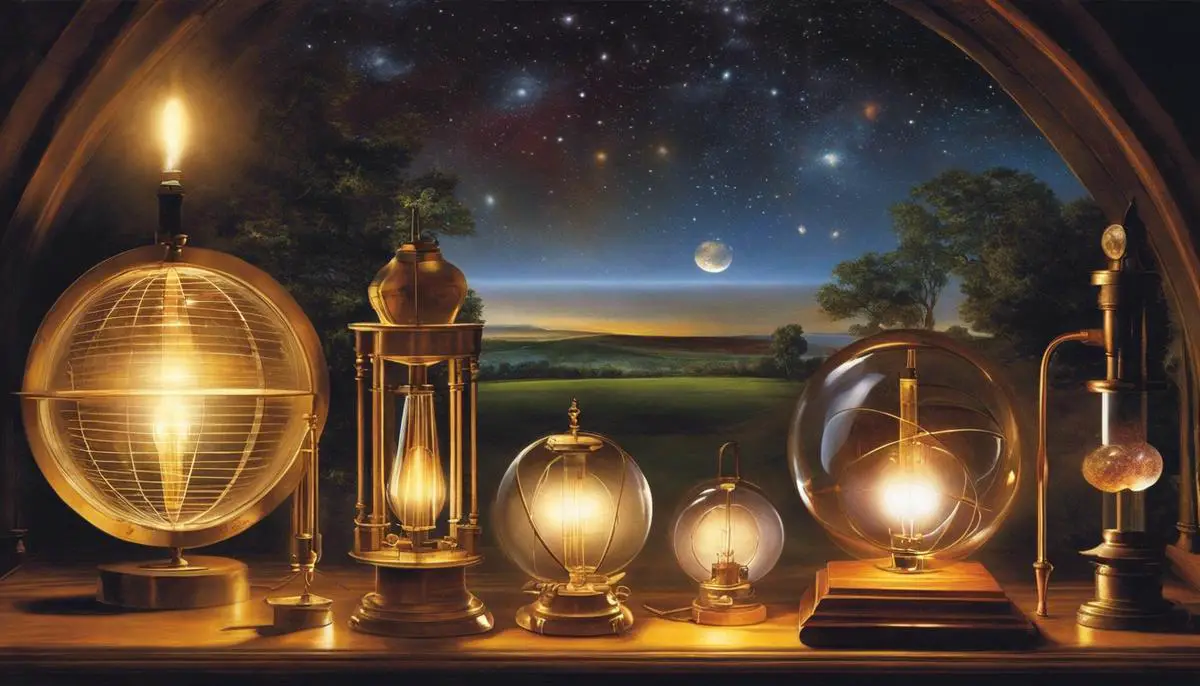The quest to quantify the speed of light stands as one of the most captivating stories in the annals of science. Its narrative runs deep through the veins of history, intertwining philosophical conjectures, astronomical inquiries, and groundbreaking experiments. From the early musings of ancient philosophers to the sophisticated exploration conducted by trailblazing scientists, the study of light’s velocity reveals as much about the evolution of human thought as it does about the fundamental qualities of the cosmos. This exploration commenced with mere curiosity and transformative ideas, growing through the centuries into a pursuit that has shaped our understanding of the very fabric of reality.
Early Concepts and Attempts to Measure
Title:
The Conception of Light’s Velocity in Ancient Philosophical Inquiry
Abstract:
The subject of light’s velocity has captivated the intellects of ancient philosophers for millennia, igniting debates that would, in due course, form the bedrock of modern optical science. The deliberations of these early thinkers on the nature of light and its movement through space were not mere idle musing but a genuine attempt to uncover and comprehend a fundamental aspect of our natural world. This discourse ventures to probe into the historical conceptions held by ancient philosophers regarding the speed of light – a topic that, while appearing elusive to the technological reach of the era, nevertheless benefitted from a profundity of introspective and logical scrutiny.
Main Body:
In antiquity, the parsing of light’s attributes oft resulted in a confluence of philosophical discourse and empirical observation. Nonetheless, within this amalgam, the specific element of light’s speed presented a towering challenge. A quintessential proposition was that light’s velocity was instantaneous – a perspective embraced by many including the acclaimed scholar Empedocles of Acragas, who flourished in the fifth century BCE. His assertion was founded upon the observation that upon opening one’s eyes, one is immediately bathed in light; hence, light must traverse space with no perceptible duration.
This notion of instantaneous transmission was further propounded by esteemed thinkers such as Euclid and Ptolemy, whose voluminous treatises on optics failed to disaggregate the speed of light from the concept of instantaneity. Their serious commitment to studying light’s behavior through geometric optics unfortunately did not extend into quantifying its speed.
By contrast, it was the Alexandrian philosopher and engineer, Hero, who dared to raise queries regarding the finite nature of light’s speed. His conjectures, though groundbreaking, lacked the methodological rigor to transition from hypothesis to experimentally supported theory.
The intellectual tide, however, began to shift with the musings of the Babylonian Talmudic scholars, whose text intriguingly alludes to a perceptible span required for light from the setting sun to fill the sky. Yet, even such astute observation did not precipitate a mathematical interrogation of light’s velocity. It is in the writings of the Islamic philosopher, Alhazen, where we find the earliest nuanced understanding that the propagation of light is not a temporal nullity. His “Book of Optics,” a magnum opus by any measure, laid the groundwork for perceiving light as a phenomenon with a quantifiable speed, though the technology of the age rendered actual measurement an impossibility.
Conclusion:
In surveying the vast tapestry of ancient philosophical expositions on the speed of light, one finds a blend of reasoned speculation and a discernible, insatiable curiosity. The ancient conceptualization of light’s speed stands as testament to the inherent yearning to unlock the secrets of the cosmos, a pursuit that is still fervently alive today. In tracing this lineage of thought, it becomes apparent how the abstract musings on the nature of light paved the way for modern scientific exploration and inquiry – from Galileo’s attempt to time the flashing of lanterns atop distance peaks to Ole Rømer’s celestial measurements. Thus, from supposing instantaneity to intimating finitude, the philosophical dialogue on the speed of light has irrevocably enriched the annals of scientific advancement.

Ole Rømer’s Astronomical Observations
Against the rich tapestry of historical thought on the speed of light, the contributions of Ole Rømer stand as a monumental pivot from theory to empirical measurement that captured the attention of the scientific community. It was in the year 1676 that Rømer, a Danish astronomer working at the Paris Observatory, made an observation that would fundamentally alter our understanding of the nature of light.
Observing the moons of Jupiter, particularly the orbit of Io, Rømer recognized a perplexing inconsistency: the intervals at which Io was eclipsed by Jupiter were shorter when Earth was approaching Jupiter in its orbit and longer when Earth was receding. This discrepancy could not be accounted for by mechanics alone and suggested an astonishing hypothesis—light did not travel instantaneously but rather traversed space at a finite speed.
Illustrating a keen analytical mind, Rømer proposed that the observed variances were due to the time it took for light from Io’s eclipses to reach Earth. As the distance between Jupiter and Earth changed, so too did the amount of time it took for the light to bridge the gap between the celestial bodies. Calculating the difference in time between the observed and expected eclipses, Rømer astutely surmised that light took approximately 22 minutes to cross the diameter of Earth’s orbit around the sun.
This revelation was nothing short of revolutionary, providing the first quantitative estimate of the speed of light. Although Rømer’s calculations did not yield the exact value accepted today, his methodology laid the groundwork for a new realm of celestial mechanics. The precision of his estimates was understandably limited by the observational tools of his time, yet it was unequivocal that Rømer had broken new ground.
Rømer’s empirical approach, intersecting with contemporary developments in telescopic technology and timekeeping, translated the historically philosophical debate into a verifiable domain of physics. Consequently, Rømer’s findings catalyzed a series of investigations culminating with more refined measurements and shaping the path toward modern astrophysics and the advanced concepts of spacetime.
In essence, Rømer’s deductions charted a trajectory of scientific thought substantiated by evidence, not purely abstract reasoning. It underscored the transition from a purely speculative approach to a more rigorous, empirical methodology. Henceforth, the speed of light assumed the role of a fundamental constant within the framework of physical laws, shaping our conceptions of the vast cosmological distances and the intrinsic limitations of universal information exchange.
The discovery by Ole Rømer, therefore, remains a cornerstone in the edifice of physical science: a testament to the untiring quest for understanding that drives human inquiry, and a poignant reminder of how meticulous observation and daring postulation can uncover the very fabric of our universe.

Fizeau’s Experiment and Refinement
Advancing from the empirically-grounded studies of Ole Rømer—who notably proposed the finite speed of light in the 17th century as indicated by the discrepancies in the apparent motion of Jupiter’s moon Io—it was not until the 19th century that a landmark experiment conducted by Armand Hippolyte Louis Fizeau carved a more precise path toward mastering the elusive measure of luminous velocity. Fizeau ingeniously merged scientific rigor with technological innovation to surmount the substantial hurdles posed by the speed of light’s enormity.
The refinement of Fizeau’s innovative methodology cannot be overstated. In 1849, Fizeau executed a terrestrial measurement of light’s speed with unanticipated ingenuity. He employed a beam of light directed at a mirror several kilometers away, with a rotating toothed wheel situated in the beam’s path, creating an intermittent light source. As the light traveled to the distant mirror and reflected back, the speed of the wheel’s rotation was carefully adjusted until the returning light was observed to pass through the next gap in the spinning wheel.
This synchronization, which Fizeau meticulously orchestrated, allowed him to calculate the time taken for light to travel to the mirror and back using the known distance and the rotational speed of the wheel. The speed of light, therefore, became a function of these measurable variables. Essentially, Fizeau had transformed a conceptually infinite metric into a tangible quantity by segmenting the light’s journey into countable intervals.
Fizeau’s apparatus employed cogitation and craftsmanship to achieve unprecedented experimental control, with the experiment itself demanding a formidable balance of precision engineering and astute observation. Of particular importance was the calibration of the toothed wheel speed, representing a novel approach to temporal measurement in physics.
It is crucial to draw attention to the monumental significance of Fizeau’s contribution. His experiment provided a groundbreaking method of ascertaining the speed of light with a remarkable degree of accuracy given the era, confirming light’s finite velocity and laying the groundwork for future measurements. Subsequently, refinements were made by other prominent scientists such as Léon Foucault who improved upon Fizeau’s original technique.
Fizeau’s valiant quantification of light’s velocity has served as a cornerstone for modern optical science and has permeated a plethora of scientific disciplines. The determination of the speed of light was not merely a technical triumph; it represented a pivotal transition—a quantum leap, if you will—from speculative philosophy to empirical physics. The fundamental nature of the speed of light underpins Einstein’s relativity and continues to influence cosmology, astrophysics, and the burgeoning field of quantum mechanics.
Indeed, Fizeau’s methodology engendered a cascade of advancements, influencing both the precision of light speed measurements and the exploration of the properties of light itself. As a fundamental constant, light’s speed is integral to our capacity to comprehend our universe, acting as a universal gauge for both the microscopic and cosmological scales.
This concise exposé on Fizeau’s experiment serves as a reverent homage to the relentless pursuit within the scientific community to unlock the mysteries of nature’s constants. Through such endeavors, our understanding of the very fabric of reality is continually refined and expanded.

Maxwell’s Theoretical Groundwork
The Dispersion of Electromagnetic Waves and Maxwell’s Theoretical Foundation on the Speed of Light
The endeavor to comprehend the speed of light has transcended millennia, with each epoch augmenting the lexicon of understanding with empirical evidence and theoretical constructs. The progression from speculative philosophy to quantitative discernment brought forth a transformative period in the 19th century, characterized by James Clerk Maxwell’s profound contributions which elucidated the relationship between electricity, magnetism, and optics.
Maxwell, distinguished for his inaugural perceptions pertaining to electromagnetic fields, offered a theoretical corpus that interlaced prior empirical phenomena with a cogent framework, explicating the propitious actions that govern light’s propagation. His equations, a set of differential equations that describe the behavior of electric and magnetic fields and their interdependencies, conducted a symphonic convergence of knowledge, yielding an inference that the speed of light is an inherent feature of the electromagnetic field constants in a vacuum.
Utilizing the values of the vacuum permittivity and permeability, constants instrumental in defining the strength of the electric and magnetic fields respectively, Maxwell computed an estimation for the velocity of light. His calculations unveiled an alignment with the experimental measurements of the time for light, corroborating the theory that light — undulations of electric and magnetic fields in a unified electromagnetic wave — travels at a finite speed that is interlinked to the electromagnetic characteristics of the medium.
The salient notion that light and electromagnetism were two facets of a single phenomenon was groundbreaking, introducing a theoretical cornerstone for modern physics. This insight spurred the integration of optics with electromagnetism, presaging a unified theory of electromagnetism, now foundational in the study of physical interactions at both macroscopic and quantum scales.
Furthermore, Maxwell’s formulation seductively suggested that light, as an electromagnetic wave, should not be confined merely to visible wavelengths. Such an assertion anticipated the detection of a panoply of electromagnetic waves, encompassing radio waves, X-rays, and gamma rays, thus delineating the profound electromagnetic spectrum.
Additionally, Maxwell’s exposition on light’s velocity played a paramount role in the genesis of Albert Einstein’s special theory of relativity. By positing that light’s speed in a vacuum is the same for all observers, irrespective of the relative motion between the source and the observer, Maxwell’s work inadvertently laid the foundation for a revolutionary conception of space and time.
In summary, Maxwell’s theoretical insights into the speed of light underpin a monumental transition in understanding electromagnetic phenomena — the demarcation of classical and modern physics. With his unassailable acumen, he not only explicated the hitherto inexplicable but also set the stage for transformative advancements that would inexorably alter the realm of theoretical physics and its application to comprehend the cosmos. As a testament to Maxwell’s lasting influence, the continued marriage of refined experimental methodologies and theoretical inquiry paves the path to unravel the myriad mysteries within the cosmological theatre and the behemoth expanse of electromagnetic interactions.

The Speed of Light as a Fundamental Constant
The Epistemological Odyssey to C’s Constancy: Maxwell’s Legacy and the Rise of Relativistic Physics
The authoritative discourse on the velocity of luminosity underwent a pivotal metamorphosis with the prodigious formulations of James Clerk Maxwell. To comprehend the magnitude of Maxwell’s contributions is to recognize the connectivity between disparate entities—electromagnetism and optics—that were previously considered unrelated. It is within Maxwell’s four partial differential equations, devised in the latter half of the 19th century, that a synthesis of the electric and magnetic fields is found, conceptualizing them as fluctuating reciprocally in space to manifest light waves.
These rigorous formulations, now eponymously known as Maxwell’s equations, elucidated the propagation mechanism of electromagnetic waves, a category inclusive of visible light. The profundity of Maxwell’s work resided in the insight that light, an electromagnetic phenomenon, travels at a velocity, c, which can be delineated by the permittivity and permeability of free space (the vacuum constants ε₀ and μ₀, respectively). This velocity, vital to the tenets of electromagnetism, was found to hold an invariant magnitude across the reference frames stipulated in Maxwell’s theoretical framework.
Maxwell’s revelation consequently led to a profound unification within the scientific community, amalgamating the once separate domains of optics and electromagnetism under a singular, comprehensive theoretical umbrella. His work expanded our grasp of the electromagnetic spectrum, pushing the boundaries beyond the narrow sliver of visible light to encompass a vast continuum from gamma rays to radio waves, each distinguished by its frequency and wavelength, yet all traversing space at this immutable pace.
This intellectual odyssey presaged the foundational groundwork for the emergent theories of relativity that would revolutionize the fabric of physics. The enigmatic and invariant speed of light comported an insuperable challenge to classical Newtonian mechanics, constraining the veritable Albert Einstein to remodel the conceptual framework of time and space.
Einstein’s special theory of relativity, unveiled in the dawn of the 20th century, inextricably linked the constancy of light’s speed to the relativity of simultaneity, time dilation, and length contraction. The legitimacy of c’s constancy as a universal speed limit became enshrined in the annals of physics, reverberating through the disciplines of cosmology, quantum mechanics, and the study of the very genesis of the cosmos.
The ramifications of Maxwell’s equations and their confirmation of the speed of light as a steadfast constant continue to echo through the corridors of contemporary scientific inquiry. The modern pursuit of understanding quantum field theories, the behavior of particles in accelerators, and the vast network of signals proliferating through fiberoptic cables all pivot on the fundament laid by Maxwell’s elucidation of electromagnetic phenomena.
Continual are the explorations and experimental validations seeking to probe the omnipresent influence of this celestial constant, firmly cementing the role of the speed of light as a cornerstone of the theoretical edifice of physics. As the pursuit of knowledge steadfastly progresses, the scientific gaze remains fixated on unveiling the deepest mysteries of the universe, fortifying the empirical canon and the pantheon of scientific apprehension for generations to come.

Photo by dcharlesschuett on Unsplash
Through a tapestry woven of experimental ingenuity and theoretical brilliance, the quest to understand the speed of light has indelibly altered the course of science. It has navigated the centuries from archaic notions of infinite velocity to a precise value enshrined in the sacred constants of physics. The culmination of this journey, marked by the confluence of empirical evidence and elegant theory, not only redefined our conception of light but also molded our grasp of space and time. The history of speed of light discovery is a testament to human curiosity and intellectual endeavor, a chronicle of how a seemingly insurmountable mystery can become a cornerstone of our knowledge of the natural world.
![]()
